Two-Camera Mounts for Microscopes
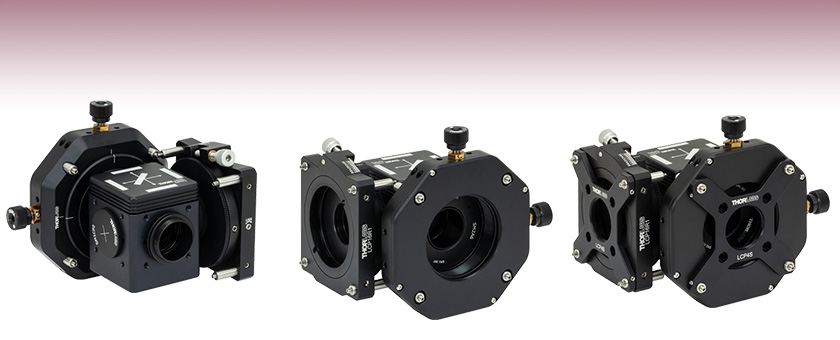
- Mount Two Cameras for Two-Channel Imaging
- Compatible with Thorlabs' Cerna® Series and Other Microscopes
- Designed for Thorlabs' Scientific Cameras
2CM1
Mount for Cameras Compatible with
60 mm Cage Systems
Front
Back
2CM2
Mount for Cameras Compatible with
30 mm Cage Systems

Please Wait
| Suggested Compatible Optics |
|---|
| Fluorescence Imaging Filters (Dichroic Mirrors, Emission Filters, Excitation Filters) |
| Longpass and Shortpass Dichroic Mirrors |
| Hot and Cold Mirrors |
| Plate Beamsplitters |
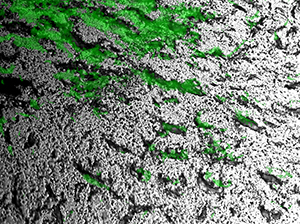
Click to Enlarge
Figure 1.1 This image shows a live, simultaneous overlay of fluorescence and near-infrared Dodt contrast images of a 50 µm brain section from a CX3CR1-GFP mouse. More details can be found on the Applications tab. Sample courtesy of Dr. Andrew Chojnacki, University of Calgary.
Features
- Microscope Adapters Allow Two Scientific Cameras to Image a Single Optical Input (See the Applications Tab for Examples)
- Ideal for Calcium Ratio Imaging and Electrophysiology
- Accepts 25 mm x 36 mm Dichroic Filters or Beamsplitters
- Accepts Standard Ø25 mm or Ø1" Filters on Outputs
- Fine Pitch Rotation and XY Adjustment for Image Registration
- Coarse Focus Adjustment for Parfocalization
- Adapts to Most Cerna, Olympus, and Nikon Upright Microscopes Using Thorlabs' Standard SM1 Interface (Microscope Camera Port Adapters Sold Separately)
- Supported by ThorCam™ Image Overlay Plug-In for Our Scientific Cameras
These two-camera mounts are designed to attach two Thorlabs scientific cameras to an upright Cerna, Olympus, or Nikon microscope, allowing simultaneous imaging of a single optical output. Typical applications include multispectral imaging using a dichroic beamsplitter; for more details please see the Applications tab. A rotation mount allows for 360° of rotational adjustment (±8° fine adjustment) for the reflected camera while a translation mount gives 4 mm linear XY adjustment of the transmitted camera. Both camera mounts have coarse focus adjustment by manually translating the cameras, allowing for parfocalization of both images. The 2CM1 and 2CM2 mounts have up to 15 mm and 11 mm of adjustment, respectively, using the cage rods, although this adjustment range may be limited by the geometry of the camera's front face.
The 2CM1 mount is designed for cameras with 60 mm cage system taps on the front, such as our cooled sCMOS and CMOS cameras, while the 2CM2 mount is identical except for the inclusion of two LCP4S cage size adapters for compatibility with 30 mm cage system taps, such as those found on our compact scientific cameras with sCMOS and CMOS sensors.
Each mount includes a DFM1 fluorescence filter cube, which is designed to hold a fluorescence filter set (dichroic mirror, excitation filter, and emission filter) as well as 25 mm x 36 mm plate beamsplitters or other optics (up to 1.1 mm thick). The filter cube consists of a base and top lid with an insert to hold filter set components and has a kinematic design for easy swapping between mounted filter sets without requiring realignment. Additional DFM1T1 top lids for mounting different filter sets are sold separately below. See the Applications tab for example uses.
Microscope Compatibility
The input port of each two-camera mount has external SM1 (1.035"-40) threading that can mate with our SM1-threaded microscope camera port adapters for installation on many commercial upright microscopes. The 2CM1 and 2CM2 mounts place our scientific cameras' sensors at a distance of 4.05" to 4.17" (102.9 mm to 106.0 mm) from the base of the mount, which may be outside the parfocal distance of some microscopes, including inverted microscopes from Nikon and Olympus. For these microscopes, our two-camera mounts can be used if parfocality with the eyepieces is not needed.
These mounts will be parfocal with Thorlabs' Cerna® Series Microscopes with our previous-generation inverted-image trinoculars, as well as upright microscopes from Nikon and Olympus. For Cerna Series Microscopes with inverted-image trinoculars and upright Nikon Eclipse microscopes, these mounts can be attached to the trinoc camera port using our SM1A58 camera port adapter. For Olympus BX and IX microscopes, Thorlabs offers the SM1A51 camera port adapter with SM1 threading. These mounts are not compatible with our upright-image trinoculars.
Turnkey prealigned systems with cameras and three-way camera mounts are also available as custom items. Please contact Tech Support for more details.
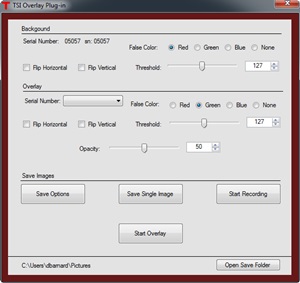
Click to Enlarge
Figure 1.2 Screenshot of ThorCam Overlay Plug-in
| Table 1.3 Scientific Cameras Selection Guide |
|---|
| sCMOS |
| 2.1 MP |
| CMOS |
| 2.3 MP |
| 5.0 MP |
| 5.0 MP Polarization Camera |
| 8.9 MP |
Compatible with Thorlabs' Scientific Cameras
- High Quantum Efficiency
- Low Read Noise
- Polarization Camera Available
- Triggered and Bulb Exposure Modes
- Image Aquisition Software Package and GUI
- Third-Party Software Support for LabVIEW®, MATLAB®, µManager, and Metamorph®
These two-camera mounts are ideal for use with Thorlabs' scientific cameras, which have four 4-40 tapped holes on the front camera face for mounting to the two-camera mounts.
Thorlabs' scientific cameras are based on high quantum efficiency, low-noise imagers, which make them ideal for multispectral imaging, fluorescence microscopy, and other high-performance imaging techniques. Both non-cooled and cooled versions are available. For more details about our camera families, please click on the links in Table 1.3.
The ThorCam user interface for our scientific cameras includes a plug-in to allow for two live camera images to be overlaid into a real-time 2-channel composite, eliminating the need for frequent updates of a static overlay image. This live imaging method is ideal for applications such as calcium ratio imaging and electrophysiology. As seen in Figure 1.2, the plug-in controls image threshold and opacity (Alpha) settings, and can apply false color to one of the two monochrome channels. Please refer to the Applications tab for more examples.
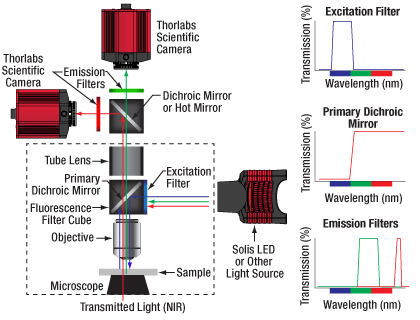
Click to Enlarge
Figure 2.1 Example Setup for Simultaneous NIR/DIC and Fluorescence Imaging
Live Dual-Channel Imaging
Many life science imaging experiments require a cell sample to be tested and imaged under varying experimental conditions over a significant period of time. One common technique to monitor complex cell dynamics in these experiments uses fluorophores to identify relevant cells within a sample, while simultaneously using NIR or differential interference contrast (DIC) microscopy to probe individual cells. Registering the two microscopy images to monitor changing conditions can be a difficult and frustrating task.
Live overlay imaging allows both images comprising the composite to be updated in real-time versus other methods that use a static image with a real-time overlay. Overlays with static images require frequent updates of the static image due to drift in the system or sample, or due to repositioning of the sample. Live overlay imaging removes that dependency by providing live streaming in both channels.
Using the ThorCam overlay plug-in with the two-way camera microscope mount, users can generate real-time two-channel composite images with live streaming updates from both camera channels, eliminating the need for frequent updates of a static overlay image. This live imaging method is ideal for applications such as calcium ratio imaging and electrophysiology.
Example Images
Simultaneous Fluorescence and DIC Imaging
Figures 2.2 and 2.3 show mouse kidney cells imaged using a dichroic filter to separate the fluorescence and DIC signals into different cameras. These images are then combined into a two-channel composite live image with false color fluorescence by the ThorCam overlay plug-in (see Figure 2.4).
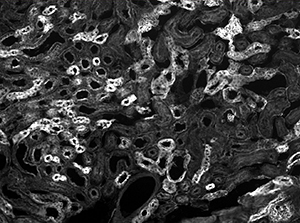
Click to Enlarge
Figure 2.2 Fluorescence Image
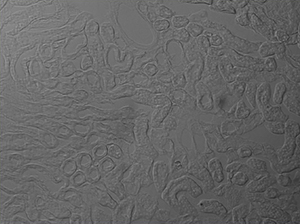
Click to Enlarge
Figure 2.3 DIC Image
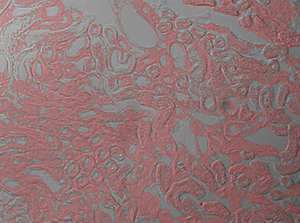
Click to Enlarge
Figure 2.4 2-Channel Composite Live Image
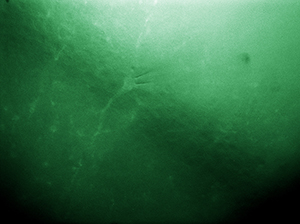
Click to Enlarge
Figure 2.5 In the image above, the pipette is visible in the DIC image as two lines near the center of the frame.
Microaspiration Using a Micropipette
Figure 2.5 shows a live, simultaneous overlay of fluorescence and DIC images. The experiment consists of a microaspiration technique using a micropipette to isolate a single neuron that expresses GFP. This neuron can then be used for PCR. This image was taken with our previous-generation 1.4 megapixel cameras and a two-camera mount and shows the live overlay of fluorescence and DIC from the ThorCam plug-in. Image courtesy of Ain Chung, in collaboration with Dr. Andre Fenton at NYU and Dr. Juan Marcos Alarcon at The Robert F. Furchgott Center for Neural and Behavioral Science, Department of Pathology, SUNY Downstate Medical Center.

Click to Enlarge
Figure 2.6 This image shows a live, simultaneous overlay of fluorescence and near-infrared Dodt contrast images of a 50 µm brain section from a CX3CR1-GFP mouse. More details can be found on the Applications tab. Sample courtesy of Dr. Andrew Chojnacki, University of Calgary.
Simultaneous NIR Dodt Contrast and Epi Fluorescence imaging
Figure 2.6 shows a live, simultaneous overlay of fluorescence and near-infrared Dodt contrast images of a 50 µm brain section from a CX3CR1-GFP mouse, which has been immunostained for PECAM-1 with Alexa-687 to highlight vasculature. The Dodt contrast uses a quarter annulus and a diffuser to create a gradient of light across the sample that can reveal the structure of thick samples. The image was taken with our scientific cameras and a two-camera mount. Sample courtesy of Dr. Andrew Chojnacki, Department of Physiology and Pharmacology, Live Cell Imaging Facility, Snyder Institute for Chronic Diseases, University of Calgary.
Other Configurations
The 2CM1 and 2CM2 Two-Camera Mounts can also be utilized with other optics sharing the same 25 mm x 36 mm x 1 mm size of a standard dichroic mirror. Figure 2.7 suggests a two-camera imaging system designed for dual wavelength fluorescence imaging with a dichroic mirror. In Figure 2.8, a 50:50 plate beamsplitter can be used to split the signal evenly; this is useful, for example, for imaging the sample using two different cameras simultaneously.
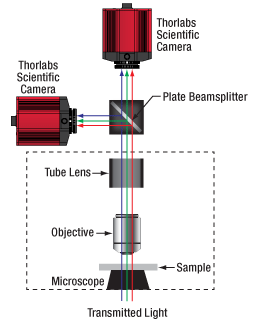
Click to Enlarge
Figure 2.8 Example Setup for Dual Wavelength Fluorescence Imaging Using a 50:50 Plate Beamsplitter
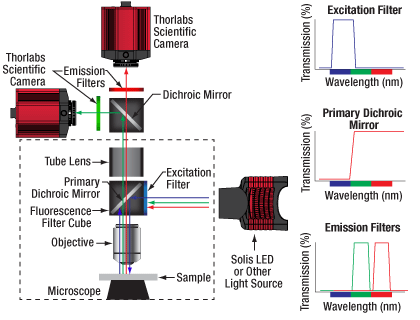
Click to Enlarge
Figure 2.7 Example Setup for Dual Wavelength Fluorescence Imaging Using a Dichroic Mirror
| Posted Comments: | |
Satheesh Kumar
(posted 2023-07-25 20:08:23.77) Can we use this product for RAMAN Spectroscopy?
This kind of beam splitter from Thorlabs we used one of our RAMAN applications. We wanted to have the same item or better than this model because as you know that this is quiet an OLD model.
We wanna use either 10X or 50X objective lens for focusing the sample in this beam splitter. In one side, 532 nm laser will be coupled and the second side, Objective lens and the third side of the beam splitter allow the signal to pass through the SMA fiber with 0.22 NA.
request you to recommend appropriate items.
PS: If you have camera just to visualize the sample surface, send us the details. cdolbashian
(posted 2023-08-16 08:54:59.0) Thank you for reaching out to us with this inquiry. I have reached out to you directly regarding the specific configuration of your intended Raman spectroscopy application, and the potential to include the 2CM2 into such a system. Pattabhi Dyta
(posted 2022-09-19 18:37:18.37) Hello,
Can these be used for C-mount machine vision cameras and
C-mount FA lenses/fixed focal length lenses ? cdolbashian
(posted 2022-09-26 04:41:00.0) Thank you for reaching out to us Pattabhi. This camera mount is designed for use with a cage-compatible camera, as the coarse adjustment is via 60 or 30mm cage rods. That being said this can technically be used with a standard C mount camera format. I have contacted you directly to discuss you application. christian
(posted 2017-12-07 17:13:27.933) Is there a way to attach 2 cameras to a microscope, being able to select camera 1 or camera 2 with a motorized 100% flipper mirror? YLohia
(posted 2018-03-26 10:14:37.0) Hello, thank your for contacting Thorlabs. Unfortunately, we currently do not have such a fixture. Your best bet would be looking into MFF101/MFF102, but these will not allow for a light-tight system. Please note that the maximum load capacity is 120g. maoyafikuddin
(posted 2017-06-21 04:38:53.183) We are trying to perform multiple fluorescence imaging in our existing Nikon inverted microscope of model TE 2000 U. For this purpose, we need a multi port camera attachment which will enable us to simultaneous image capturing as well as video recording on two camera. Therefore, requesting for availability of following components:
1. Multi port camera attachment preferably two or three
2. Attachment of fluorescence filters between the camera and camera port which is C mount.
3. A suitable model of scientific CMOS camera having resolution 1024×1024 pixel and fps of min. 40 FPS at full resolution. Must be compiled with synchronisation facility.
Any other solutions or modification to the above said system will be highly appreciated. tfrisch
(posted 2017-07-20 01:24:31.0) Hello, thank you for contacting Thorlabs. It looks like you are already in contact with our Scientific Imaging Team about potential solutions for using this with an inverted scope. |

- Microscope Adapters Allow Two Scientific Cameras to Image a Single Optical Input Simultaneously
- 2CM1 Mount for Cameras with 60 mm Cage System Taps
- 2CM2 Mount Includes Two LCP4S Adapters for Cameras with 30 mm Cage System Taps
- Optics Not Included
- Fine Pitch Rotation and XY Adjustment for Image Co-Registration
- Coarse Focus Adjustment for Parfocalization of Cameras
- Compatible with our Cerna® Series Microscopes
Our 2CM1 and 2CM2 Two-Camera Mounts have SM1-threaded input ports for installation on many commercial microscopes. Each mount places the cameras at the appropriate parfocal distance when used with Thorlabs' Cerna® Series Microscopes with inverted-image trinocs, as well as upright microscopes from Nikon and Olympus. For Cerna Series Microscopes with inverted-image trinoculars and upright Nikon Eclipse microscopes, these mounts can be attached to the trinoc camera port using our SM1A58 camera port adapter. For Olympus BX and IX microscopes, Thorlabs offers the SM1A51 camera port adapter with SM1 threading. These mounts are not compatible with our upright-image trinoculars.
Thorlabs scientific cameras can be mounted using the 4-40 tapped holes on their front plates. Cameras with 60 mm hole spacings, such as our cooled Quantalux sCMOS camera, can be mounted to the 2CM1 mount. 30 mm cage system compatible cameras, such as our non-cooled Quantalux sCMOS and Kiralux CMOS cameras, can be mounted to the 2CM2 mount. These mounts are identical except the 2CM2 mount includes two LCP4S 30 mm to 60 mm Cage Plate Adapters. These adapters are necessary for cameras that are compatible with 30 mm cage systems. Note that if the two-camera mount is used with a 60 mm cage system camera and a 30 mm cage system camera, only one of the LCP4S adapters will be necessary. The adapter can be purchased separately along with a 2CM1 mount or a 2CM2 mount may be used after removing one of the adapters.

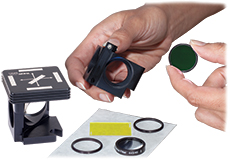
Click to Enlarge
Figure G2.1 Each filter cube insert can hold a fluorescence filter set: one dichroic mirror, one excitation filter, and one emission filter.
Additional DFM1T1 inserts allow for different filters to be swapped in and out of our two camera mounts. The kinematic design creates a repeatable alignment stop so that the system will not require realignment after the inserts are switched. Figure G2.1 shows a fluorescence filter set being installed in the DFM1T1 insert.
 Products Home
Products Home











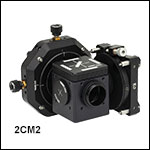
 Zoom
Zoom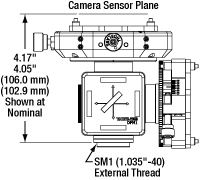

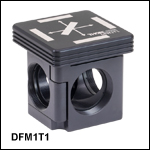
 Two-Camera Mounts for Microscopes
Two-Camera Mounts for Microscopes